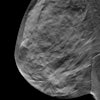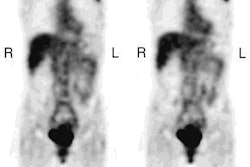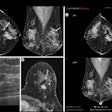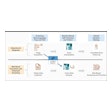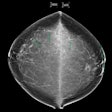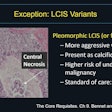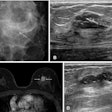SAN FRANCISCO - Women who carry BRCA1 or BRCA2 gene mutations, or run a higher risk of developing breast cancer based on family history, can benefit from routine surveillance with MRI, according to a study presented at the American Association for Cancer Research (AACR) meeting on Sunday.
"Hereditary breast cancer accounts for about 5% to 10% of all breast cancer. In about half of these families, a mutation in BRCA1 or BRCA2 is found," said Dr. Ellen Warner from the division of medical oncology at Toronto-Sunnybrook Regional Cancer Centre in Canada. "These cancers occur an average of 20 years earlier than sporadic breast cancers, so it’s not uncommon to see a mutation carrier with breast cancer in her early 20s or 30s."
The current recommended surveillance regimen for these high-risk women is yearly mammography, clinical breast examination (CBE) by a healthcare provider every six months, and monthly self breast examination (SBE) starting at the age of 25, Warner explained. "But since we really want to find these cancers at an early enough stage before they become palpable, the cornerstone of the surveillance is mammography," she added.
Previous studies have shown that mammography may not be enough, especially in younger women with dense breasts. A study out of Dr. Daniel den Hoed Cancer Center in Rotterdam, the Netherlands, tested the effectiveness of mammographic surveillance in gene mutation carriers and women with high familial risk.
"Within a median follow-up of three years, 35 breast cancers were detected; the average detection rate was 9.7 per 1,000. Overall, node negativity was 65% (and) sensitivity was 74%. Results with respect to tumor stage and sensitivity were less favorable in BRCA carriers and in women under the age of 40," the Dutch group reported (Journal of Clinical Oncology, February 2001, Vol.19:4, pp. 919-920).
Additionally, BRCA1-related cancers are less likely to be visible on mammography because of their pathology: there are fewer cases of ductal carcinoma in situ (DCIS) and less fibrosis, and the tumors tend to have "pushing" rather than the more common infiltrating borders, Warner said. The high mitotic rate associated with BRCA1 means interval cancers are more likely to crop up between screening mammograms.
"Our hope was that MRI, with or without ultrasound, would find all the cancers detected by mammography, and many more, so that we could eventually abandon mammography for screening these women," Warner said.
For this ongoing Canadian study, 293 high-risk women have been screened at least once since November 1997, with the majority undergoing three rounds of screening. The women were between the ages of 25 and 60, with a greater than 25% lifetime risk of breast cancer. Of these 293 women, 59% were known BRCA1 mutation carriers, Warner said.
All patients underwent MRI and ultrasound, as well as mammography and clinical breast exam (CBE). Patients with suspicious enhancing lesions on MRI underwent a second, high-resolution MR study of the same breast. If the exam was still suspicious, a directed ultrasound was done. Upon confirmation with sonography, an ultrasound-guided core biopsy was performed.
"So far, we’ve found 18 cancers in 17 women, which is, unfortunately, what we’d expect in this population," Warner said.
Of the 18 cancers, 28% were >1 cm and none were >2 cm. Interval cancer was found in one case. All except one case was node negative.
"The good news is that screening detected all but one of these cancers. The only interval cancer was a 1.7-cm tumor found by a woman seven months after her third round of screening. For reasons we don’t know, she didn’t have her six-month CBE. By the time this tumor was detected, it could be seen on all three imaging modalities," Warner said.
The sensitivity for MRI was 72%, while mammography came in at 44% and ultrasound at 41%.
"MRI is clearly the winner, having picked up 72% of the cancers. But it also missed four cancers picked up by mammograpy or ultrasound," Warner said. "Three of these could be seen on MRI in retrospect, but one, a DCIS, could still only be seen on mammography. And this tells us that we still can’t use MRI as a substitute for mammography." Instead, the ideal surveillance protocol for these women might be mammography and MRI performed six months apart, she said.
However, MRI does have several drawbacks. It is an expensive exam (for this study, Warner estimated that it cost $1,000 per screening) and it is harder to perform ultrasound-guided biopsy based on MRI results: The false-positive biopsy rate after one round of MRI screening in this study was 10%.
Also, the logistics of an MR exam can be tricky, including coordinating the scan with the second week of a woman’s menstrual cycle, accommodating obese patients, and addressing patient discomfort brought on by claustrophobia or the intravenously administered contrast agent, Warner said.
Still, MRI was able to pinpoint cancers that the other modalities did not. Of the 17 women diagnosed with breast cancer in this study, all are alive and disease-free at a median follow-up of 35 months, Warner said.
The group will continue their research into routine surveillance with MRI, and hope to have 300 patients undergo at least three rounds of screening, Warner said. In addition, they plan to incorporate MRI-guided core biopsy into the protocol. Finally, they would like to spearhead a meta-analysis of other MRI breast studies to determine issues such as optimal screening intervals and the long-term survival of a screening population.
By Shalmali Pal
AuntMinnie.com staff writer
April 8, 2002
Related Reading
MRI superior to mammography in screening high-risk women for breast cancer, July 27, 2001
Many women have unrealistic expectations about genetic test for breast cancer, April 5, 2001
Gene profiling could refine breast imaging, March 22, 2001
Copyright © 2002 AuntMinnie.com
